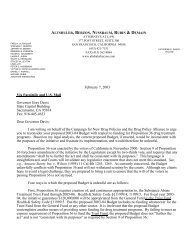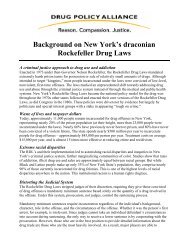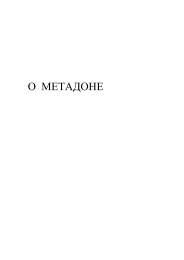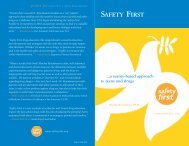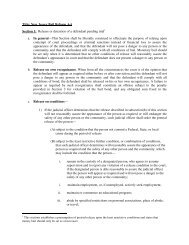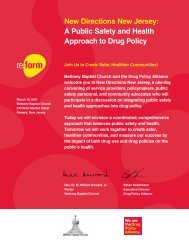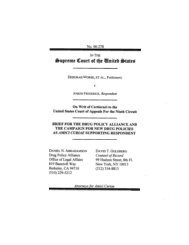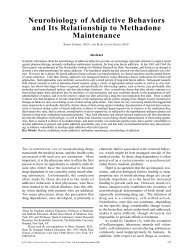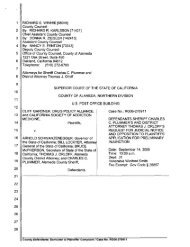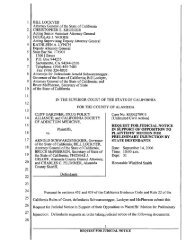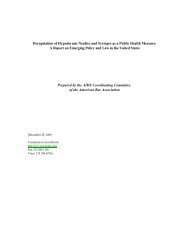Drug Policy And Health In Romania - Drug Policy Alliance
Drug Policy And Health In Romania - Drug Policy Alliance
Drug Policy And Health In Romania - Drug Policy Alliance
Create successful ePaper yourself
Turn your PDF publications into a flip-book with our unique Google optimized e-Paper software.
DRUG POLICY AND HEALTH IN ROMANIA<br />
A Profile Prepared by the <strong>Drug</strong> Law and <strong>Health</strong> <strong>Policy</strong> Resource Network<br />
21 February 2002<br />
<strong>Policy</strong> <strong>In</strong>dicators<br />
HIV EPIDEMIC STATUS:<br />
MAIN TRANSMISSION MODE:<br />
DRUG POLICY CONDITIONS:<br />
LAW ENFORCEMENT PRACTICES:<br />
INTERVENTION LEVEL:<br />
___________<br />
INJECTION DRUG USE<br />
___________<br />
___________<br />
___________<br />
CONTENTS<br />
Summary<br />
HIV/AIDS<br />
OTHER INFECTIOUS DISEASES<br />
INJECTION DRUG USE<br />
LAW AND LAW ENFORCEMENT PRACTICES<br />
PUBLIC HEALTH INTERVENTIONS<br />
ECONOMIC AND SOCIAL INDICATORS<br />
Full Report<br />
INTRODUCTION<br />
HIV/AIDS<br />
OTHER INFECTIOUS DISEASES<br />
INJECTION DRUG USE<br />
LAWS AND LAW ENFORCEMENT PRACTICES<br />
PUBLIC HEALTH INTERVENTIONS<br />
SOCIOPOLITICAL ENVIRONMENT<br />
REFERENCES<br />
<strong>Romania</strong> – 21 February 2002 - 7
Summary<br />
I. HIV/AIDS<br />
<strong>Romania</strong> has seen an AIDS explosion, especially in the juvenile population. With<br />
almost 9,000 HIV infected children, <strong>Romania</strong> is the home of over 50% of Europe’s<br />
pediatric HIV/AIDS cases. Those numbers are expected to increase due to increasing<br />
drug use and sexual activity among <strong>Romania</strong>’s 5,000 street children.<br />
HIV Cases By Mode of Transmission, 2000<br />
15%<br />
0%<br />
84%<br />
0%<br />
1%<br />
Hetero<br />
Homo/Bi<br />
IDU<br />
Perinatal<br />
Other<br />
Source: 13<br />
New HIV <strong>In</strong>fections per Million<br />
Population<br />
40<br />
30<br />
20<br />
10<br />
0<br />
1993 1994 1995 1996 1997 1998 1999 2000<br />
Source: (13)<br />
<strong>Romania</strong> – 21 February 2002 - 7
II.<br />
OTHER INFECTIOUS DISEASES<br />
The incidence of tuberculosis in <strong>Romania</strong> is the worst in this part of Europe.<br />
Growing poverty, natural disasters and worsening social conditions are the root of the<br />
problem.<br />
Cases per 100,000 Population<br />
140<br />
120<br />
100<br />
80<br />
60<br />
40<br />
20<br />
0<br />
Syphilis<br />
TB<br />
1993<br />
1995<br />
1997<br />
1999<br />
Sources: (12) (13)<br />
III.<br />
INJECTION DRUG USE<br />
<strong>Drug</strong> Use. <strong>Drug</strong> use is growing, especially among children. It is believed that the<br />
prevalence of drug use among teenagers is about 98%.<br />
Risk Behavior <strong>In</strong>formation. Child drug users have been switching from paint<br />
thinner to heroin. They often put their money together for one syringeful and share the<br />
needle.<br />
Social Attitudes. For many years, drug use did not officially exist in <strong>Romania</strong>.<br />
The lack of education on the subject led to uninformed fearful parents. <strong>Drug</strong> users are<br />
seen as weak-willed people.<br />
IV.<br />
LAW AND LAW ENFORCEMENT PRACTICES<br />
<strong>Romania</strong> is a democracy, which is divided among a parliament, an executive and<br />
a judiciary. <strong>In</strong> general, rights of the accused are respected and conditions are continually<br />
improving. However, there are several incidents of abuse by police and of prisoners.<br />
<strong>Romania</strong> – 21 February 2002 - 7
Law on the Books<br />
? The government is divided into a<br />
presidency, a judiciary and a parliament<br />
? Those accused of a crime have the right<br />
to an attorney<br />
? Those being detained on suspicion of a<br />
crime may request a hearing within 24<br />
hours.<br />
Actual practice<br />
? The executive has been known to<br />
exercise some control over the judiciary<br />
? Those accused are not always informed<br />
of their rights<br />
? Detainees have been known to be<br />
beaten at times<br />
V. PUBLIC HEALTH INTERVENTIONS<br />
Harm Reduction Programs Generally. Open Society <strong>In</strong>stitute funds four<br />
programs, all in Bucharest. The <strong>Romania</strong>n government has tried to distribute condoms<br />
and educate people on drug use, however it lacks resources.<br />
<strong>Drug</strong> Treatment. There are very few drug treatment programs. The few that<br />
exist are detoxification programs operated out of hospitals.<br />
VI.<br />
ECONOMIC AND SOCIAL INDICATORS<br />
The Transparency Corruption Perceptions <strong>In</strong>dex (CPI) ranks countries in terms of<br />
the degree to which corruption is perceived to exist among public officials and<br />
politicians. <strong>In</strong> 2001, the rank for <strong>Romania</strong> was 69 out of 91 countries.<br />
The Human Development <strong>In</strong>dex value is a composite index measuring average<br />
achievement in three basic dimensions of human development-a long and healthy life,<br />
knowledge and a decent standard of living. <strong>In</strong> 1999, <strong>Romania</strong> ranked 68 of the 174<br />
countries measured.<br />
The GINI index measures the extent to which the distribution of income (or in some<br />
cases consumption expenditures) among individuals or households within an economy<br />
deviates from a perfectly equal distribution. The GINI index of zero equals perfect<br />
equality, while and index of 100 implies perfect inequality. The GINI index for the most<br />
resent reported year for <strong>Romania</strong> was unavailable.<br />
Unemployment refers to the share of the labor force without work but available<br />
for and seeking employment. Definitions of labor force and unemployment differ by<br />
country. <strong>Romania</strong>’s unemployment rate in 1997 was 6.0%.<br />
The Gross Domestic Product (GDP) is the total of all economic activity in one<br />
country, regardless of who owns the productive assets. <strong>In</strong> 2000, the GDP was<br />
unavailable. The average annual growth of the economy from 1990 to 1999 was<br />
unavailable.<br />
<strong>Romania</strong> – 21 February 2002 - 7
DRUG POLICY AND HEALTH IN ROMANIA<br />
A Profile Prepared by the <strong>Drug</strong> Law and <strong>Health</strong> <strong>Policy</strong> Resource Network<br />
Full Report<br />
I. INTRODUCTION<br />
The <strong>Drug</strong> Law and <strong>Health</strong> <strong>Policy</strong> Resource Network is an international research<br />
collaboration designed to improve data collection and policy analysis on drug policy and<br />
health in the countries of Eastern Europe and the Former Soviet Union. The information<br />
in this report was gathered by staff at Temple University’s Beasley School of Law and<br />
the University of Connecticut <strong>Health</strong> Sciences Center. It will be augmented by further<br />
research in 2002 by network collaborators in the study region.<br />
This Report presents available information in six domains: HIV/AIDS, other<br />
infectious diseases, injection drug use, law and law enforcement practices, public health<br />
interventions, and economic and social indicators. It concludes that <strong>Romania</strong> is in the<br />
early stages of a serious HIV epidemic driven primarily by injection drug use. With<br />
sufficient external support and dramatic internal changes in drug policy and law<br />
enforcement practice, a public health effort against HIV and other blood-borne diseases<br />
could be successful.<br />
II.<br />
HIV/AIDS<br />
Accurate and complete data on HIV in <strong>Romania</strong> are not available. The data<br />
presented here are from a variety of sources and may not entirely agree. These data<br />
generally do not represent HIV incidence, and depend heavily upon patterns of HIV<br />
testing and reporting that remain very incomplete in the most severely affected countries.<br />
HIV infection is defined as an individual with HIV infection confirmed by a laboratory<br />
according to country definitions and requirements. AIDS cases are reported according to<br />
a uniform AIDS case definition originally published in 1982 and revised in 1985, 1987<br />
and for adults and adolescents (age >13) in 1993. The 1993 European AIDS surveillance<br />
case definition differs from that used in the United States in that it does not include CD4<br />
lymphocyte criteria.<br />
Overall Data. Since 1985, 2,263 children and 288 adults have died from AIDS in<br />
<strong>Romania</strong>. (5) Most of <strong>Romania</strong>’s HIV/AIDS cases have been caused by non-sterile<br />
medical equipment and contaminated blood. (3) <strong>Romania</strong> is home to over 50% of all<br />
pediatric AIDS cases in Europe. (4) Its almost 9,000 infected children is thought to be<br />
caused by <strong>Romania</strong>’s leader in the 1980’s. <strong>In</strong> an effort to increase the population, he<br />
outlawed contraception, social workers and HIV screening. Also, many children received<br />
needless blood transfusions during this time period. The problem is expected to worsen<br />
because 85% of <strong>Romania</strong>’s 5,000 street children are sexually active. The disease moves<br />
<strong>Romania</strong> – 21 February 2002 - 7
at different rates in different children. Therefore, some parents who merely thought there<br />
children were sick now realize that their children have AIDS. (6)<br />
Data from The European Center for the Epidemiological Monitoring of AIDS<br />
Year<br />
Reported<br />
AIDS cases<br />
Reported<br />
New HIV<br />
infections<br />
# Rate/<br />
Homo/bi<br />
Contact<br />
#<br />
<strong>In</strong>jection<br />
<strong>Drug</strong> Use<br />
#<br />
Heterosexual<br />
Contact<br />
#<br />
Perinatal<br />
Transmission<br />
#<br />
# Rate/<br />
HIV AIDS HIV AIDS HIV AIDS HIV AIDS<br />
Million Million<br />
1993 447 19.5 234 10.2 - - - - - - - -<br />
1994 494 21.6 722 31.6 - - - - - - - -<br />
1995 698 30.7 854 37.6 - - - - - - - -<br />
1996 560 24.7 699 30.9 16 1 1 0 77 80 32 19<br />
1997 588 26.1 650 28.8 1 1 1 1 33 30 24 22<br />
1998 638 28.4 648 28.8 3 7 0 0 68 68 19 19<br />
1999 380 17.0 364 16.2 4 6 0 0 74 83 16 16<br />
2000 557 24.9 290 12.9 1 2 0 0 43 221 5 10<br />
(12)(13)<br />
Regional Distribution.<br />
Stigma and Social Attitudes toward HIV/AIDS. People with HIV are held<br />
responsible for the spread of the disease. (3) This leaves children with HIV/AIDS at a<br />
special risk for abandonment. (4) Many <strong>Romania</strong>ns think that punishing gay men will<br />
stop AIDS. School education avoids talking of sexual orientation, venereal diseases and<br />
HIV education. (7)<br />
III.<br />
OTHER INFECTIOUS DISEASES<br />
The spread of HIV is related in important ways to the incidence of other<br />
infectious diseases. Non-sterile injection drug use is a risk factor not only for HIV, but<br />
also Hepatitis. <strong>In</strong>carceration in many countries in this region is a risk factor for<br />
tuberculosis. Sexually transmitted diseases may increase the likelihood of HIV<br />
transmission during sex.<br />
<strong>Romania</strong> – 21 February 2002 - 7
<strong>Romania</strong> appears to be in the midst of growing epidemics of TB and syphilis.<br />
Public health is worsening due to poverty, natural disasters and worsening social<br />
conditions. The incidence of tuberculosis in <strong>Romania</strong> is the worst in the region. (9)<br />
Data from (12) (13)<br />
Year TB Syphilis Hepatitis<br />
# Rate/<br />
100,000<br />
Rate/<br />
100,000<br />
Hepatitis Hepatitis<br />
A B C<br />
# # #<br />
1993 - - 26 - - -<br />
1994 - - 29 - - -<br />
1995 23,271 102.4 35 - - -<br />
1996 24,113 106.4 32 - - -<br />
1997 24,350 107.7 32 - - -<br />
1998 25,623 113.5 34 - - -<br />
1999 26,107 116.5 37 - - -<br />
2000 - - 45 - - -<br />
IV.<br />
INJECTION DRUG USE<br />
This section reports available information about drug use levels, trends and risk<br />
behaviors, as well as social attitudes about drug use and information about the problem of<br />
drug overdose. <strong>Drug</strong> treatment and other interventions to reduce the morbidity and<br />
mortality of drug use are discussed in section V, below. Data about drug use come<br />
primarily from unofficial sources, including more or less rigorous rapid assessments,<br />
consultant reports and the news media.<br />
Summary of situation. <strong>Drug</strong> use is growing among children. <strong>In</strong> urban areas,<br />
drug use among teenagers is thought to be 97-98%, especially in the cities that function<br />
as gates for drug traffic, Bucharest, Constanta and Timisoara. <strong>Drug</strong> use is rare among<br />
children in rural areas, which lack profitable marketplaces for dealers. (10)<br />
Trends in <strong>Drug</strong> Use. Low salaries earned by most <strong>Romania</strong>ns make narcotics too<br />
expansive. Still, law enforcement officials noted a trend of increasing domestic drug use.<br />
The trend is most noticeable in consumption of cannabis and synthetic drugs as "ecstasy",<br />
among the nation's youth. (1)<br />
Risk Behavior. Child drug users often engage in high-risk behavior. As one<br />
filmmaker put it, “Heroin has replaced (the paint thinner) Aurolac. One child can’t afford<br />
a syringe, so you will have five kids chipping in for one syringeful and then sharing a<br />
needle.” (18)<br />
<strong>Romania</strong> – 21 February 2002 - 7
<strong>Drug</strong> Traffic <strong>In</strong>formation. <strong>Romania</strong> is not a major producer of narcotics.<br />
However, the country lies on a route used to funnel heroin and opium from Afghanistan<br />
through Turkey to Western Europe. This is known as the Northern Balkan route.<br />
<strong>Romania</strong> is also a used as a depot and transit point for South American cocaine traveling<br />
to Western Europe. A large amount of precursor chemicals transit <strong>Romania</strong> from Western<br />
European countries south toward Turkey. <strong>Drug</strong>s are also brought into <strong>Romania</strong> via the<br />
Black Sea port of Constanta, as well as the country's international airports. Only 20<br />
percent of the drugs moving through <strong>Romania</strong> are consumed domestically. (1)<br />
Social Attitudes Toward <strong>Drug</strong> Users. There is a serious lack of knowledge<br />
among the country's youth regarding the dangers of abusing drugs. (1) Officially drug use<br />
did not exist in <strong>Romania</strong> for many years. However, as the nation’s politics continue to<br />
change, the awareness of drug use is also expected to increase. (3) <strong>Romania</strong>n teenagers<br />
describe drug users as having a weak personality, as being irresponsible, a coward, stupid<br />
and dirty. Adults say they feel unprepared to handle this problem. They are afraid and<br />
feel as if they have no help. (10)<br />
<strong>Drug</strong> Overdoses.<br />
V. LAWS AND LAW ENFORCEMENT PRACTICES<br />
A. <strong>Drug</strong> Law<br />
This section describes what is known about both the drug-related laws on the<br />
books and the way these laws are enforced. The section covers syringe access, drug<br />
possession, drug treatment, drug trafficking, and the handling of drug arrestees and<br />
prisoners within the criminal justice system. It also lists the international drug-related<br />
instruments to which the country is a signatory.<br />
Syringe Access/Needle Exchange Programs - Law.<br />
Syringe Access/Needle Exchange Programs - Practices.<br />
Substitution Therapies.<br />
<strong>Drug</strong> possession Law.<br />
<strong>Drug</strong> Possession Law-Practices.<br />
<strong>Drug</strong> treatment Law.<br />
Compulsory Treatment –Practices.<br />
<strong>Romania</strong> – 21 February 2002 - 7
<strong>Drug</strong> Trafficking Law. Law 143/2000, which was passed August 2000, gives<br />
the national police expressed powers to carry out controlled deliveries of narcotics and<br />
allows for the use of undercover police in the investigation of drug-related activities. (1)<br />
<strong>Drug</strong> Treatment Regulation.<br />
<strong>Drug</strong> Treatment Regulation-Practices.<br />
Criminal Justice System- Law. <strong>Romania</strong> is a multi-party democracy. There is a<br />
bicameral parliamentary system, a head of the government, a directly elected head of<br />
state and a judicial branch. No one can be held for more than 24 hours without an arrest<br />
order from the prosecutor. The prosecutor may then order detention for up to 30 days.<br />
However, the accused may ask for bail and hearing from a judge. The request for a<br />
hearing must be granted within 24 hours. The accused has the right to counsel. (19)<br />
Criminal Justice System- Practices. <strong>In</strong> general, the rights of the accused are<br />
respected. However, in some cases detainees have been beaten and those accused are not<br />
always informed of their rights. Prisons are improving as more money is being allocated<br />
to their budgets. They have instituted training programs. However, the prisons still use a<br />
system in which some prisoners are placed in charge of other prisoners. As a result, there<br />
have been several incidents of abuse reported. (19)<br />
<strong>In</strong>ternational drug conventions signed. The country is a party to the following<br />
international drug agreements.<br />
? 1988 UN <strong>Drug</strong> Convention<br />
? Extradition treaty with the United States<br />
? Mutual Legal Assistance Treaty with the United States<br />
? UN Convention on the Trafficking of Illicit Narcotics and Psychotropic<br />
Substances<br />
? UN Convention Against Transnational Organized Crime and its Protocols<br />
(December 2000) (1)<br />
B. Public <strong>Health</strong> and Human Rights Law<br />
This section describes what is known about public health and human rights law on<br />
the books, as well as the way these laws are enforced. The section covers the rights to<br />
healthcare, privacy, reportability and anti-discrimination generally and for HIV/AIDS<br />
patients. It also lists the international human rights instruments to which the country is a<br />
signatory.<br />
Right to <strong>Health</strong> Care/ Right to HIV Treatment –Law.<br />
Right to <strong>Health</strong> Care/ Right to HIV Treatment –Practice. <strong>Romania</strong>n hospitals<br />
cannot afford to take care of all the nation’s HIV children. Some children live in state<br />
hospitals, but many live with their families in orphanages or in small apartment<br />
<strong>Romania</strong> – 21 February 2002 - 7
“orphanages” run by a charity named Heart of the Child. The hospitals and charities<br />
cannot afford drugs for all the children. Anti-retroviral cocktails cost $10,000 per child.<br />
<strong>In</strong> one hospital only 120 of the 400 infected outpatient children are on the cocktails. One<br />
doctor reported, “if he had enough money, 100 more would be (on the cocktails, because<br />
they met <strong>Romania</strong>’s virus level criteria. If they were in the United States, all 400 would<br />
be.” (6)<br />
Reportability of HIV, AIDS, HCV, HBV – Law and Practice.<br />
HIV Testing Provisions–Law and Practice. HIV testing was made mandatory<br />
for all STD and TB patients. (8)<br />
Anti-Discrimination Provisions based on HIV or drug use – Law and<br />
Practice.<br />
Privacy Generally and HIV in Particular –Law.<br />
Privacy Generally and HIV in Particular –Practice. The media, eager for<br />
scandal, often reveals a person’s HIV status. Medical staff often breach confidentiality<br />
without impunity. The <strong>Romania</strong>n press is subject to no ethical guidelines for the<br />
confidentiality of a person’s HIV status. (7)<br />
Criminal Penalties for Exposing/Transmitting HIV. Article 309, paragraph 2,<br />
of the Penal code criminalizes “transmission of AIDS” by “a person who knows<br />
him/herself to suffer from that disease.” (11)<br />
Criminalization of Prostitution –Law and Practice.<br />
Criminalization of Homosexuality –Law and Practice. The Orthodox Church<br />
campaigns aggressively against same-sex relationships. The public discourse with sexual<br />
minorities, including their vulnerability to AIDS has been poor. (7)<br />
Status of <strong>In</strong>ternational Human Right Conventions. <strong>Romania</strong>’s status in<br />
relation to major international human rights instruments follows.<br />
? <strong>In</strong>ternational Covenant on Economic, Social and Cultural Rights<br />
(CESCR): signed December 9, 1974<br />
? <strong>In</strong>ternational Covenant on Civil and Political Rights (CCPR): signed<br />
December 9, 1974<br />
? <strong>In</strong>ternational Covenant on Civil and Political Rights, Optional Protocol<br />
(CCPR-OP1): signed July 20, 1993<br />
? <strong>In</strong>ternational Covenant on Civil and Political Rights, Second Optional<br />
Protocol (CCPR-OP2-DP): signed February 27, 1991<br />
<strong>Romania</strong> – 21 February 2002 - 7
? <strong>In</strong>ternational Convention on the Elimination of All Forms of Racial<br />
Discrimination (CERD): signed September 15, 1970<br />
? Convention on the Elimination of All Forms of Discrimination Against<br />
Women (CEDAW): signed January 7, 1982<br />
? Convention on the Elimination of All Forms of Discrimination Against<br />
Women, Optional Protocol (CEDAW-OP): signed September, 2000<br />
? Convention Against Torture and Other Cruel, <strong>In</strong>human or Degrading<br />
Treatment or Punishment (CAT): signed December 18, 1990<br />
(2)<br />
VI.<br />
PUBLIC HEALTH INTERVENTIONS<br />
This section provides information on interventions to reduce HIV transmission<br />
and other health problems among drug users, the availability of drug treatment, and HIV<br />
prevention programs.<br />
A. <strong>In</strong>terventions to Reduce Disease and Other <strong>In</strong>juries Associated With<br />
<strong>Drug</strong> Use<br />
Government Position. The <strong>Romania</strong>n Ministry of <strong>Health</strong> maintains some<br />
programs designed to educate young people about the dangers of drug use. These efforts<br />
are hampered by a lack of resources. (1) <strong>In</strong> 1994, <strong>Romania</strong> established a Ministerial<br />
Committee on HIV/AIDS. It stopped functioning in 1996 without generating any policy.<br />
Now only the Medical Commission of the Ministry of <strong>Health</strong> is concerned with<br />
HIV/AIDS. (7)<br />
As on advocate said, “There have been three changes in the minister of health in<br />
four years,” she said. “It’s chaos. Some talk of seizing the patents, but then they leave.”<br />
“No one in the government will do this by themselves,” she said. “Not unless they have a<br />
personal interest, like an HIV infected friend of something. This is <strong>Romania</strong>. Here the<br />
bureaucrats say: “What HIV people? We need to get rid of them.” (6)<br />
Needle Exchange Programs. Open Society <strong>In</strong>stitute funds four harm reduction<br />
programs all in Bucharest. Some drug dependant people are afraid to make contact. The<br />
programs attempt to reach the people who are afraid through clients they already have.<br />
One of the programs focuses on prisoners, another sex workers. (17)<br />
<strong>Drug</strong> Treatment Programs/Availability. Detoxification programs are offered<br />
through some hospitals. But they are in very limited supply. (1)<br />
Summary of Situation.<br />
Substitution Therapies.<br />
<strong>Romania</strong> – 21 February 2002 - 7
B. Public <strong>Health</strong> Measures to Prevent HIV and other Significant Diseases<br />
Government Efforts/Attitudes. The government has tried to distribute<br />
disposable gloves, condoms and blood-testing kits. (3)<br />
Programmatic Details.<br />
The total number of HIV tests performed, excluding unlinked anonymous testing<br />
and testing of blood donations by year (1996 – 2000) was:<br />
1996:<br />
1997:<br />
1998:<br />
1999:<br />
2000:<br />
The rate of HIV testing /1000 population was<br />
VII.<br />
SOCIOPOLITICAL ENVIRONMENT<br />
A variety of data and data indices are commonly used to characterize social,<br />
political and economic factors in a country. The following are several of these for<br />
<strong>Romania</strong>.<br />
Perceived corruption in government is measured by the Transparency Corruption<br />
Perceptions <strong>In</strong>dex (CPI) ranked countries in terms of the degree to which corruption is<br />
perceived to exist among public officials and politicians. The most recent measure was<br />
in 2001.<br />
? Country Rank: 69 of 91 countries<br />
? 2001 CPI Score: 2.8 out of a possible 10<br />
? Surveys Used: 5<br />
? Standard Deviation: 0.5<br />
? High-Low Range: 2.0 - 3.4<br />
(14)<br />
The GINI index measures the extent to which the distribution of income (or in<br />
some cases consumption expenditures) among individuals or households within an<br />
economy deviates from a perfectly equal distribution. A Lorenz curve plots the<br />
cumulative percentages of total income received against the cumulative number of<br />
recipients, starting with the poorest individual or household. The GINI index measures<br />
<strong>Romania</strong> – 21 February 2002 - 7
the area between the Lorenz curve and the hypothetical line of absolute equality,<br />
expressed as a percentage of the maximum area under the line. This the GINI index of<br />
zero equals perfect equality, while and index of 100 implies perfect inequality<br />
? GINI <strong>In</strong>dex, 1998: unavailable<br />
The Human Development <strong>In</strong>dex is a composite index measuring average<br />
achievement in three basic dimensions of human development-a long and healthy life,<br />
knowledge and a decent standard of living.<br />
? Human Development <strong>In</strong>dex Rank (HDI) in 1999 – 68/174 (8)<br />
Unemployment rates refer to the share of the labor force without work but<br />
available for and seeking employment. Definitions of labor force and unemployment<br />
differ by country.<br />
? Unemployment rate (1997) - 6.0 % (8)<br />
Standard & Poor's <strong>In</strong>surer Financial Enhancement Rating is a current opinion of<br />
the creditworthiness of an insurer with respect to insurance policies or other financial<br />
obligations that are predominantly used as credit enhancement and/or financial<br />
guarantees. The ratings range from ‘CC’, which is defined as “currently highlyvulnerable”<br />
to a rating of ‘AAA’, which is defined as “extremely strong” capacity to<br />
meet its financial commitments.<br />
? Local Currency:<br />
? Long-Term rating: B+<br />
? Outlook: Positive<br />
? Short-Term Rating: B<br />
? Foreign Currency:<br />
? Long-Term rating: B<br />
? Outlook: Positive<br />
? Short-Term Rating: B<br />
The Social <strong>In</strong>dicators of Poverty represents the health status of individuals in<br />
different socioeconomic groups within countries for the last survey year (1995).<br />
? <strong>In</strong>fant Mortality Rate:<br />
Poorest Quintile:<br />
Richest Quintile:<br />
? Child Immunization Rate:<br />
Poorest Quintile:<br />
Richest Quintile:<br />
<strong>Romania</strong> – 21 February 2002 - 7
? Prevalence of Child Malnutrition:<br />
Poorest Quintile:<br />
Richest Quintile:<br />
? Low Mother’s Body Mass <strong>In</strong>dex:<br />
Poorest Quintile:<br />
Richest Quintile:<br />
? Total Fertility Rate:<br />
Poorest Quintile:<br />
Richest Quintile:<br />
The National Poverty Line is the measurement of the percentage of the population<br />
below the defined income level of poverty. <strong>In</strong> <strong>Romania</strong> the percentage of the<br />
population that has an income below the poverty line is unavailable.<br />
? Population Below the Poverty Line, (BPL), 1996: unavailable<br />
The Gross Domestic Product (GDP) is the total of all economic activity in one<br />
country, regardless of who owns the productive assets. The GDP per capita is the total<br />
output divided by the population. This value is then adjusted to convert to a common<br />
currency, which adjusts for national variations in the process paid for goods and services.<br />
There has been a precipitous decline in GDP in <strong>Romania</strong> during the last decade with an<br />
average annual growth rate in the economy of unavailable<br />
Gross Domestic Product per Capita (PPP US$): <strong>Romania</strong><br />
Gross Domestic Product - Average Annual Growth:<br />
1980-1990: ---<br />
1990-1999:<br />
Gross Domestic Product in $ USD Millions:<br />
1990:<br />
2001:<br />
(19)<br />
<strong>Romania</strong> – 21 February 2002 - 7
VIII.<br />
REFERENCES<br />
1) <strong>In</strong>ternational Narcotics Control Report, 2001,<br />
http://www.state.gov/g/inl/rls/nrcrpt/2000/index.cfm?docid=892<br />
2) Office of the United nations High Commissioner for Human Rights, Status of<br />
Ratifications of the Principal <strong>In</strong>ternational Human Rights Treaties, 26 Jun<br />
2001, http://www.unhchr.ch/pdf/report.pdf<br />
3) www.drugtext.org/count/rom.html<br />
4) HIV/AIDS Program, www.kappa.ro/holt/eholt-h.html<br />
5) Fleishman, Jeffrey, "<strong>Romania</strong> has half Europe's Juvenile AIDS Caseschildren<br />
in <strong>Romania</strong> bear an AIDS Legacy". Philadelphia <strong>In</strong>quirer 12/06/98,<br />
p. A25.<br />
6) <strong>Romania</strong>'s AIDS Children: A Lifeline Lost.<br />
7) Macovei, Monica and Coman, Adrian. "Implications for HIV/AIDS of Laws<br />
Affecting Men Who Have Sex With Men <strong>In</strong> <strong>Romania</strong>". http://www.acceptromania.ro/msmeng.html<br />
8) Epidemiological fact Sheet on HIV/AIDS and Sexually Transmitted<br />
<strong>In</strong>fections, 2000 Update, http://www.unaids.org<br />
9) Sparrows, John. "<strong>Romania</strong>'s Human Challenge". 4 Jul 2001.<br />
http://www.reliefweb.int<br />
10) Stoica-Constantin, Ana; Constantin, Ticu; Rogojina, Didina and Baciu,<br />
Sergiu. "<strong>Drug</strong>-Use among Teenagers in <strong>Romania</strong> and the Republic of<br />
Moldavia". http://www.psih.uaic.ro/cticu_drog_engl.html<br />
11) Public Scandals: http://www.ilga.org<br />
12) WHO Europe Communicable Disease, WHO Regional Office for Europe,<br />
1999 - 2001, http://cisid.who.dk/<br />
13) HIV/AIDS Surveillance in Europe, End-year Report 2000, European Centre<br />
for the Epidemiological Monitering of AIDS, 2001, N°64, http://www.eurohiv.org<br />
14) Corruption Perceptions <strong>In</strong>dex 2001, Transparency <strong>In</strong>ternational,<br />
June 27, 2001,<br />
http://www.transparency.org/documents/cpi/2001/cpi2001.html<br />
15) Sovereign ratings List, Standard & Poor's, August 3, 2001,<br />
<strong>Romania</strong> – 21 February 2002 - 7
http://www.standardandpoors.com/RatingsActions/RatingsLists/<br />
So…/SoverignsRatingsList.htm<br />
16) CIA -- The World Factbook 2000,<br />
http://wwwcia.goc/cia/publications/factbook/geos/pl.html<br />
17)<br />
http://www.soros.org/harm-reducation/resourceguide/text/IHRD7.html#<strong>Romania</strong><br />
18) Sinagra, Laura, “Beneath Bucharest – Edet Belzberg’s Children Underground<br />
goes deep into the world of <strong>Romania</strong>’s street kids”<br />
http://www.citypages.com/databank/22/1092/article9929.asp<br />
19) U.S. Department of State, <strong>Romania</strong> Country Report on Human Rights<br />
Practices for 1998. http://www.hri.org/docs/USSD-Rights/1998/<strong>Romania</strong>.html<br />
<strong>Romania</strong> – 21 February 2002 - 7



